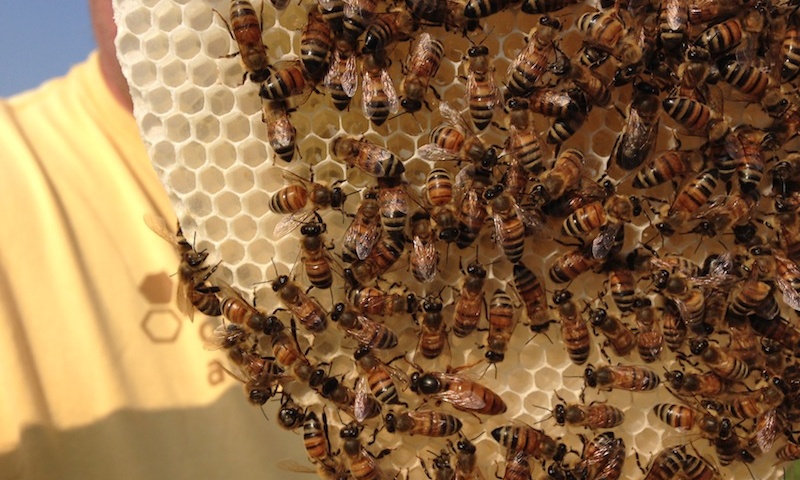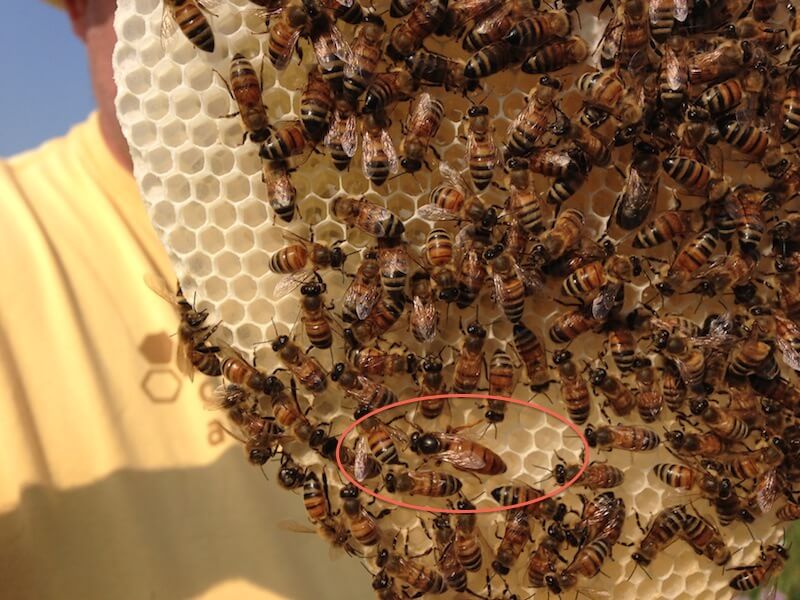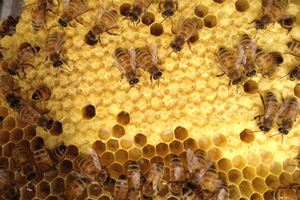- All-In-One Beekeeping for the Bees
- +1-608-728-8233
- info@beepods.com
Queen Spotting Tips for Newbee Beekeepers

Can you spot the queen?

Can you spot her? She’s a Carniolan Queen, which means she has a black abdoman. I’ve provided a key below if you’re having trouble spotting her!
The Queen
The elegant, industrious, and often elusive Queen Bee has been a figure of fascination for centuries for both Beeks and non-Beeks alike. The strength and continuation of the hive resides on her (relatively) large shoulders. She is central to the health of the hive, which is why it is so completely, unbelievably, maddeningly frustrating when you can’t seem to locate her during an inspection.
I understand the pain, truly I do. I was inspecting a hive recently and was absolutely sure she was in there. Not to brag, but I’m getting very good at this queen spotting thing. I am the one writing this post, after all. It drives me nuts when I know she’s evading me. I finally saw her casually walking around of the bottom of the hive. Not even on comb. So. Frustrating.
So, to help all of you newbees out there, I’ve created a guide of what I do during a hive inspection to give you the best possible chance at spotting the star of the show.
Anatomy
I think we can all agree that knowing what a queen is supposed to look like does not necessarily guarantee spotting her. The rest of my tips are related to a queen’s nature and behavior, but I would be remiss if I didn’t at least touch on the physical features that separate her from other bees. The queen bee is the longest bee in the colony, with short wings. She has a long, tapered abdomen, not a rounded one like drones. She has a large thorax (think shoulders) that is shiny, not fuzzy like workers and drones. Her eyes are the smallest, and are separated. Worker bees have medium sized eyes that are also separated. Drones have large eyes that are touching. Queens come in a variety of colors, depending on breed. Italians tend to be gold-hued, while Carniolan are deep black, for example. Knowing your queen breed’s color can help greatly with spotting. If you received a marked queen, yay for you! That means the beekeeper she came from used a special marker and placed a bright spot on her thorax that makes spotting very easy. Don’t become too reliant on the mark, though. It can wear off fairly easily.

Italian Queen
Take a Macro View
It is very easy to fall into the fruitless game of scrutinizing each individual bee to try to find her. There are tens of thousands of bees in a colony. Trust me, you’ll make yourself crazy that way. The first thing I do during an inspection is take an extended overview of the comb in total as soon as I remove it from the hive. Chances are, your queen will notice that she is no longer in darkness and will be on the move. She cuts a wide path when she’s moving- the bees part to make room for her, plus she leaves a distinct open trail behind her that becomes easy to spot. She’ll be moving to a location where she feels protected, which brings me to my next point.

Can you see her? She has a wide path behind her as she heads for the edge of the comb.

What about now? You can just spot the mark on her back. It’s almost completely rubbed off.

There she is. Heading toward the edge to make a quick escape.
The Queen’s Evasive Nature
If your queen is on to you, she’ll be come quite evasive. In a Top Bar Hive, this means she might head to the top of the comb, where it connects to the bar. She likes to hang out in that groove and sometimes bees will collude and cover her. Gotta admire the team spirit. She also likes to move to the other side of the comb when you’re inspecting one side. Then she’ll move back when you inspect the other side. Clever girl. Due to this bit of trickery, I often look near the outside edges of the comb to see if I can spot her switching sides.
The evasiveness includes her movements in the hive overall. If you are inspecting the back, she’ll sometimes move to the front bars. Often I won’t spot her until the very front bars, depending on her level of alarm. If her level of alarm is low you may catch her hard at work, which brings me to my next point.
She’s Got a Big Job
In her lifetime an queen could lay 1,000,000 eggs. In a day, she can lay 2,000 eggs in 30 second intervals. These stats are possible, but not necessarily probable based on your particular queen. Even if she’s not hitting that 2,000/day mark, she’s still working all day laying eggs. Given that information, it is very likely that you have caught her in the delicate state of laying an egg. So, half of her very long body, the most distinctive part, will be hidden from you in a cell. This is why I always recommend focusing your search near freshly laid eggs, instead of areas of comb containing capped brood or honey. She is most likely to be near eggs, because the comb in that area is ready for laying. If you are lucky, you may even catch her laying a few eggs. A process I highly recommend taking a few moments to observe if given the opportunity.

A queen hard at work.
She’s Got Friends
Or, more accurately, attendants that watch over her and take care of her every need. They make sure she is fed, groomed, and her bodily functions are taken care of. They surround her in a circle facing her as she moves about the hive. Now, just to add to the confusion for newbees, a similar circle of bees does appear regularly in the hive. This other circle surrounds a bee performing the navigation waggle dance, something you will never see a queen perform. If the bee is shaking and moving in a figure eight, it’s not the queen, I promise.

A queen with her attendants.
I hope these tips help on your future queen seeking adventures.
Best of Luck!
Key:


Laura Maigatter
Latest posts by Laura Maigatter (see all)
- Bees Pollinating Flowers & Gathering Last-minute Nectar in Fall - November 16, 2016
- Queen Spotting Tips for Newbee Beekeepers - July 26, 2016
- Beepods Guide to Defend your Bees from Pesticides - June 27, 2016





